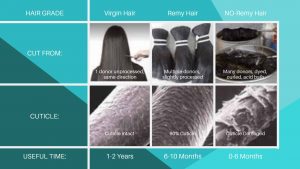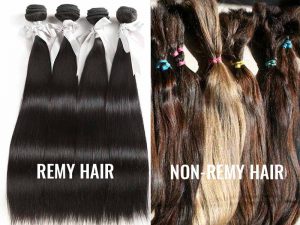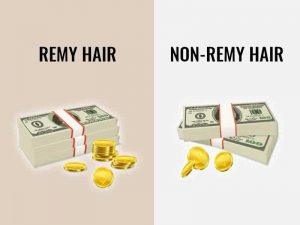Remy hair and non – remy hair: the difference between two types
Remy hair and non-remy hair are the two types of hair extensions in the hair industry. However, people still make mistakes when they mention these two types. Let’s dig into these terminologies in order to understand how to properly compare remy and non-remy hair.
The genuine definitions of remy hair and non-remy hair to compare
Let’s make sure we all understand the distinctions between these two hair types and how to properly compare remy hair and non-remy hair. Remy human hair is hair that has been collected and categorised from a variety of origins, with root to tip movement in the same direction to prevent tangling. Hair companies must utilize contemporary technology and a large workforce to ensure that the cuticle is aligned.

Remy hair & non remy hair
- Because one person’s hair may not be enough for a wig, acquiring virgin hair (one contributor) for the hair industry is particularly tough. Furthermore, practically all clients cannot afford virgin hair due to its high cost. The majority of Remy hair sources are now used by Vietnamese and Chinese hair companies. Hair can be coloured and styled in a variety of ways.
- Hair gathered from different sources is known as non-remy human hair. Because the hair is combined and not sorted by humans, the tip of the hair cannot move in the same direction as the top of the head. Indian hair factories employ non-remy hair to make their products. Many customizing styles are not possible with this type of hair extension. Curtain bangs are the safest look.
- When contrasting remy hair and non-remy hair, you can observe the change in the cuticle, which runs in the very same way in remy hair but not in non-remy hair. Despite the fact that both types of hair come from a diversity of individuals, the key difference between remy hair and non-remy hair is the term “cuticle matched.”

Remy hair and non-remy hair comparison
The distinction between remy and non-remy hair
In addition, the quality is utilized to compare remy hair and non-remy hair. People can fake the hair for their own benefit because both of them can be used as industrialized items. You may still compare remy hair and non-remy hair without the help of a hair specialist thanks to the following easy clues.
Straighten the remy hair and non – remy hair
You can see how the hair flows by combing the bundles with a hairbrush.
- It is possible that the hair is non-remy if it’s tangled despite the fact that you comb it properly. It is easy to tangle non-remy hair because the tip and top are blended.
- However, remy hair is meticulously sorted by hair producers to ensure that all of the hair grows in the same direction, so tangling is unusual.
- Chemicals can be used to market non-remy hair. It may appear attractive at first, but after cleaning, the hair tends to coil and does not last for long.

Straighten remy hair and non-remy hair
Compare remy hair and non-remy hair by the state of flaking
You can also examine the shedding situation of the hair cells when comparing remy hair and non-remy hair.
- If the hair quickly falls off the weave, it could have been wefted carelessly or come from a non-remy source. This may result in infrequent use.
- People can use remy hair for 6 to 2 years if they maintain it properly. It’s possible that non-remy hair would last a few weeks or even months.
When comparing remy and non-remy hair, the price gap is the most important factor to consider
The pricing can be used to compare remy hair and non-remy hair.
- We can find a lot of hair packages from China brands of hair extensions products being marketed at dirt cheap costs these days. The hair is wrapped in plastic and paper and bundled like toys. Non-remy hair of this sort is readily available in African hair markets.
- Remy hair costs more than non-remy hair because of the craftsmanship involved, which results in a greater form and quality. The way the hair is packed appears to be different as well. Remy hair is frequently packaged better, in nylon bags with netting to keep the texture and hang up at hair salons.
We also analyze remy and non-remy hair to see which one is most cost-effective for the consumer. Customers who are unwilling to pay a large sum of money on high quality hair may discover unclean affordable hair, which may or may not be remy hair, and tolerate any insecurity and uncomfortable conditions while using it.

The difference in price of remy hair and non-remy hair
With the above comparison, hope you have gained useful knowledge about remy hair and non-remy hair. The issue is that we need to grasp how to differentiate remy hair and non-remy hair in order to prevent wasting money on terrible hair.
For more information about remy hair and non-remy hair, contact us: 5S Hair Factory- Ms.Lily (Whatsapp: +84855555754)


